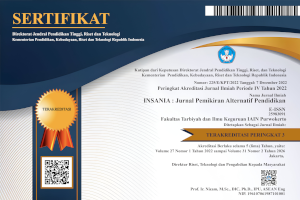Paradigma Pembelajaran Pendidikan Agama Islam Berwawasan Integratif
Abstract
Abstract: This paper describes the vision of integrative learning paradigm PAI as an effort towards the development of a new scientific paradigm that integral (comprehensive). PAI-minded new paradigm of integrative learning is thinking and perspective constantly need to be developed through practice to integrate education between religion and science. At this paradigm, learning PAI wants to develop there are three things you want to develop. The first, which eliminates the educational process or there is no dichotomy between science and religion, and science is not value-free but free assessed. In addition, the teaching of religion with science and language not only teaches the traditional side, but also the rational side. Second, building science and advancement of integrative life between the spiritual, moral and material for human life. hird, humans are able to build competition and prepare a better life in the form of humans democratic, competitive, innovative based on Islamic values . Keywords: paradigm, PAI, integrative.Downloads
Downloads
Published
How to Cite
Issue
Section
License
Authors who publish with this journal agree to the following terms:
Authors retain copyright and grant the journal right of first publication with the work simultaneously licensed under a Creative CommonsAttribution-ShareAlike License that allows others to share the work with an acknowledgment of the work's authorship and initial publication in this journal.
Authors are able to enter into separate, additional contractual arrangements for the non-exclusive distribution of the journal's published version of the work (e.g., post it to an institutional repository or publish it in a book), with an acknowledgment of its initial publication in this journal.
Authors are permitted and encouraged to post their work online (e.g., in institutional repositories or on their website) prior to and during the submission process, as it can lead to productive exchanges, as well as earlier and greater citation of published work (See The Effect of Open Access).








